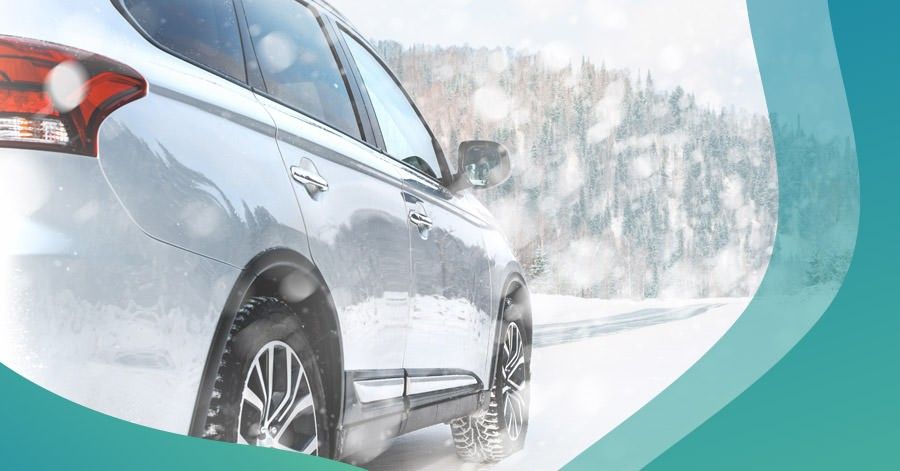After a long, hot summer, you’re probably ready for cooler temperatures, but is your car? Winter brings with it plenty of dangerous weather conditions that can make driving treacherous, such as hail, snow, and freezing temperatures. There are many precautions you can take to prepare yourself and your vehicle for the incoming winter wonderland. Read on to learn more.
Maintenance
It’s vital to maintain your vehicle in freezing temperatures. Ensuring that your car is ready for the weather will help keep you and your loved ones safe. Here are some of the ways you can make sure your vehicle is ready for those icy roads.
Check tires for tire pressure
Tire pressure can decrease about one pound per square inch for every 10 degrees the temperature drops. Temperatures fluctuating from night to day can seriously affect your tire pressure. Even if your check tire pressure light does not come on, it’s important to frequently check tire pressure in the winter months.
Monitor brakes
Winter weather may not directly affect your brakes, but you’ll definitely want them to be in tip-top shape when the roads get icy. That’s why you should take your car to a mechanic and have them test your brakes before the winter months.
Test the battery
If you’ve ever tried to start your car on a cold winter morning, you know that car batteries struggle in cold temperatures. Battery power decreases as it gets colder, which is why you should have your battery tested before the winter. Ideally, you should have a car battery that performs at or above 600 CCA to avoid breaking down in the cold weather.
Change the oil
Did you know that cold weather thickens engine oil? When oil thickens it makes it harder for vital engine parts to move properly. That’s why it’s important to switch to a lightweight oil before the winter.
Check the cabin air filter
Being able to quickly and efficiently defrost your vehicle is vital in the wintertime. To be able to do that, you need to be sure that your cabin air filter isn’t past its change date. A quick check now could save you a big headache on an icy morning.
Check belts and hoses
Belts and hoses can break down at any time, however if they go bad in the winter you may find yourself stranded in a very cold location. To avoid that scenario, check wear and tear on belts and hoses before the winter months.
Keep washer fluid full and your rear-window defroster in working order
Trying to drive when your back windshield is iced over is dangerous for you and everyone else on the road. That’s why you should check to be sure that your washer fluid is full and that it’s the right kind. Washer fluid with antifreeze makes de-icing much easier. Just be sure to maintain your supply after each use.
Clean headlights
Visibility is a major problem in the middle of a snow or ice storm. Because of this, it’s important to make sure your headlights are clean and working at the optimal level. Consider purchasing a headlight restoration kit in order remove any haze that may have gathered on your headlights.
Inspect exhaust system
You definitely don’t want carbon monoxide in the passenger compartment of your vehicle. Remember to regularly check your exhaust system for leaks.
Now that we’ve gone over some things to check before and during the winter, let’s talk about some gear that will make driving in the winter a much safer activity.
Set yourself up with winter gear
Not all car parts are meant to be used through every season. Some are better suited for warmer climates. The following suggestions feature some of the gear you can equip your vehicle with to help you commute through all types of winter weather.
Switch to winter tires
If you live in a place with frequent winter storms, it may be worth it to switch to winter tires. Winter tires are softer, so they have a better grip on the road. Plus, winter tires are made with wider grooves so they expel water and enhance traction even in slippery conditions.
Add the proper coolant
The way you add coolant, also known as antifreeze, to your car depends on the weather conditions you are expecting. There are instructions on the coolant bottle that tell you how many parts of water should be added to one part of coolant depending on what you need. Do you want protection to 0 degrees Fahrenheit, minus 20 degrees, something lower? Read the directions on the side of the coolant bottle for the correct ratio. If you don’t typically work on your own vehicle, play it safe and let a mechanic add the proper coolant for you.
Consider winter wipers
Winter wipers have rubber that keep ice and snow from collecting on the blade. They are also heavier, so they have an easier time cutting through heavy accumulation. Just be sure to remember to change back to your regular wipers once spring rolls around so you don’t wear out your wiper motor unnecessarily.
Rubber floormats
If you don’t have floormats at all, you should certainly get some before the winter to prevent ice and snow from being tracked into your car. If you want the ultimate protection, get rubber floormats. The rubber keeps the snow from seeping through your car’s carpet and into the floorboards. Just be sure you get floormats that don’t interfere with your ability to access the gas and brake pedals.
Additional preparation and best practices
Ideally, if the weather gets really bad, you want to stay home and off the roads. However, that isn’t always possible. Here are some more tips for what to do if you’re driving through a winter storm.
Keep the gas tank at least half full
If ever you are stranded in your car waiting for help to arrive in freezing conditions, you’ll appreciate having enough gas to keep the heat pumping. Plus, having a full tank of gas helps to keep condensation from causing your gas line to freeze up.
Learn winter emergency preparedness
You’ll want to know what to do if your car skids into a snow drift before you’re stuck in that dire situation. You should always stay with your vehicle, turn your car on just long enough to warm up and then shut it off again, and put dome lights on to attract the attention of someone who can help.
Learn how to drive in winter conditions
Driving in winter conditions comes with its own set of rules. Read our guide on how to drive in winter weather conditions so that you can keep yourself and other motorists safe.
Other tips to stay safe
- Use a brush and a scraper to remove ice and snow from the windshield rather than your wipers; a heavy load of snow (or ice sticking the blades to the glass) can overload the motor. If the vehicle is parked outside, lift the wipers off the glass before an overnight snow to keep them from freezing to the windshield.
- Make sure that your car’s heater is functioning properly and that plenty of warm air is being directed to the windshield when it’s in defrost mode. If your car has a separate A/C button, turn it on when defrosting; even with the temperature set to hot, the air conditioner dehumidifies the air which speeds defogging. (Most cars will automatically turn on the air conditioner with the defroster.) Don’t use the recirculate mode.
- Water can get into door and trunk locks and then freeze, locking you out of the vehicle. To prevent this, lubricate the locks with a silicone spray or door-lock lubricant. If they’re already frozen, use a lock antifreeze product to thaw them.
- Drive gently until the temperature gauge starts to move off the bottom peg or until the cold engine light (usually blue) goes out. Remember, cars can still overheat in winter, especially if the radiator grill is clogged with snow.
- Pack yourself an emergency kit that stays in your car so you’re prepared in the event of a cold-weather accident: extra blankets, gloves, socks, and matches are all great items to have in your trunk if the worst should happen.
Let Elephant help
Cold weather can be tough on you and your car. But by taking steps to prepare for it, and by practicing continued maintenance and upkeep on your vehicle, you can make sure that you’re more than ready when the first frost hits your area. To make sure you and your car are covered beyond the mechanics, get a quote with us today at elephant.com.
Article last updated on October 27th, 2023 at 12:33 pm

